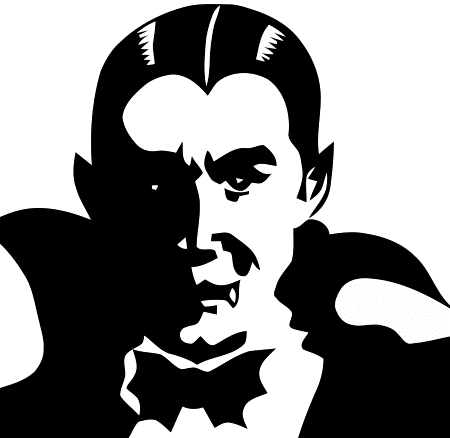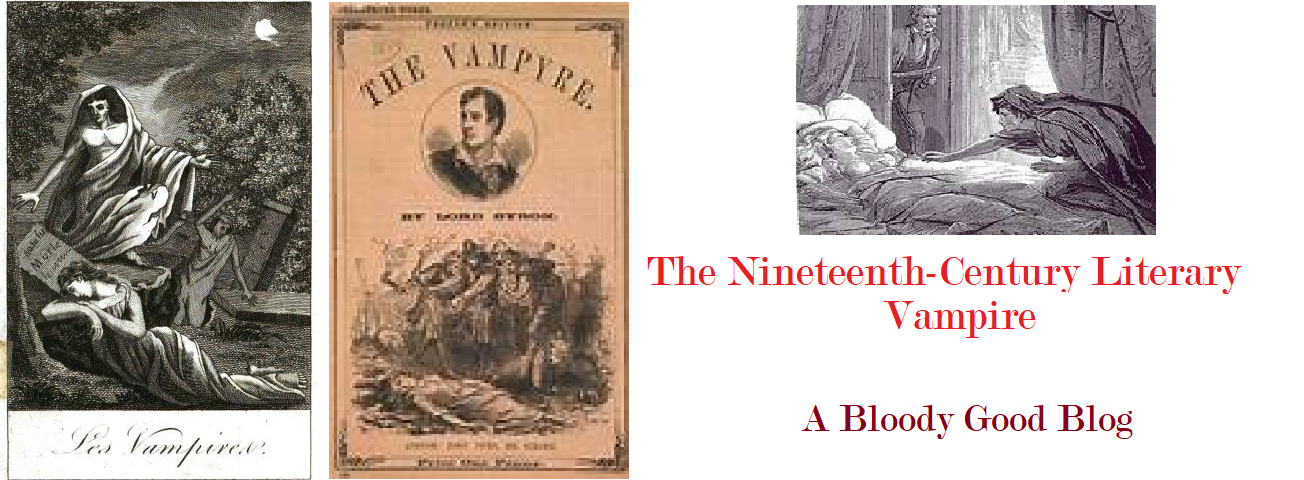
Ceskino, Little Vampire, 2009
Think of the most olden-day vampire character you know of, and then think of the most modern vampire character you know of. When thinking about each of these examples and comparing them, one can probably come up with some similarities; however, the differences in their depictions are more significant as they expose how the vampire has evolved over the years. For many years the vampire character has highlighted many anxieties within society. These anxieties change as society changes, and the vampire character has continued to evolve with and adapt to these changing anxieties, norms, and ideals. Vampires even heighten these anxieties due to their more human-like features and ability to blend in and integrate into society, which helps hide their true nefarious nature. I argue that this idea of the vampire as a socially integrated person who turns out to be a menace has evolved from the 19th century to the 21st century and changed as the depiction of vampires were altered to suit the changing anxieties and ideals or norms within society, which can be seen in John William Polidori’s The Vampyre (2019) and Jessica M. Thompson’s film The Invitation (2022).
Polidori’s vampire character Lord Ruthven fits the mold of socially integrated person turned menace extremely well. He blends in with and charms high society. Everyone becomes enamored with him, even the main character Aubrey, who agrees to travel across Europe with him. Unbeknownst to Aubrey, Lord Ruthven has done some terrible deeds during his travels in Europe, and on his apparent deathbed, Lord Ruthven makes Aubrey swear an oath to not speak his name or of his death for a year and a day. After Aubrey returns from his travels, he discovers that Lord Ruthven has returned, living under a new identity, and is now engaged to his sister. In this moment, Aubrey realizes that he has been betrayed by Lord Ruthven and is unable to do anything to save his sister now that he realizes Lord Ruthven is a vampire (Polidori). Through this brief summary, we can see how Lord Ruthven was able to pass as a member of the ton and successfully blend into society and see how he gets to a point where he betrays Aubrey and reveals his true nefarious nature.
Additionally, Polidori’s vampire character fits into what many vampire characters were made to convey in the nineteenth century. Lord Ruthven being socially integrated and turning out to be a menace conveys some of the common anxieties that were held in society during the 19th century. Harry Benshoff notes that many people “read Polidori’s sexually predatory Vampyre Lord Ruthven as a thinly disguised portrait of the bisexual libertine Lord Byron” (Benshoff 234). While the character may be based on a real person, the more notable point is the fact that the vampire character can be seen as bisexual and someone who acts without moral principles. Both of these things were looked down upon or seen as taboo in the 19th century and Lord Ruthven’s nefarious character can be seen to highlight these anxieties within society, and his character could also have served to warn against these behaviors during that time. This shows how the story, and Lord Ruthven’s character, seem to function as a cautionary tale of sorts.
When taking a deeper look at one part of Polidori’s “The Vampyre” in relation to Benshoff’s ideas, a point from Conrad Aquilina’s criticism comes to mind. Aquilina notes that the “Byronic image shares with the Romantic vampire a love of darkness, a hypnotic gaze and a paradoxical obsession with destroying the object of his desire” (Aquilina 28). Some of these Byronic elements can be seen in “The Vampyre” when Lord Ruthven learns of Aubrey’s condition towards the end of the novel. It was noted that “When he heard of Aubrey’s ill health, he readily understood himself to be the cause of it; but when he learned that he was deemed insane, his exultation and pleasure could hardly be concealed” (Polidori 29-30). Lord Ruthven could not contain the pleasure he felt when Aubrey, who he developed a relationship with, was found to be insane which connects to the idea of a vampire starting out as a socially integrated person turned menace and anxieties from the 19th century such as bisexuality and acting without moral principles that go against the societal norms.
The character Walter De Ville in the 2022 film The Invitation is another vampire character that stands out as being able to integrate themselves into the social scene but turns out to be a menace. While the society he exists in is a bit removed from modern society, if someone from the outside were to meet him, they would not be able to tell he’s a vampire or pick up on his nefarious nature right away. This is exactly the case for the heroine Evie. When she first meets Walter, she is charmed by him. He comes off as a gentleman, and even makes a great first impression after she bumps into a maid carrying a case of glasses by telling the butler to back off and taking notice of and complimenting her ceramic work (Thompson 00:14:43-00:17:30). She is continually wooed by Walter’s character, as he was also there for her when something in her room gave her a fright (Thompson 00:48:31-00:51:25). However, the bliss shared between the two comes to an end when Evie finds out Walter is a vampire, and everything was set up so she would marry him and be turned into a vampire herself in order for the three families’ continued protection and wealth as well as making the vampires all-powerful and immune to the effects of time (Thompson 01:04:53-01:14:55).
Walter De Ville’s character in The Invitation being socially integrated and turning out to be a menace seems to convey more modern anxieties. Prior to revealing his menacing nature, Walter perfectly fits into the current genre of vampire-human romances.According to Ananya Mukherjee, paranormal romance incorporates themes of masculinity and female heterosexual desire which can be seen in Walter’s relationship with Evie. Walter fits into the role of the vampire romantic hero, prior to revealing himself to be Dracula, since he allows the audience to “indulge a craving for an old-fashioned, generally wealthy, and socially dominant gentleman and a fantasy of stable and secure gendered expectations without fundamentally compromising or relinquishing hard-won and necessary, but also sometimes challenging, feminist rights and responsibilities” (Mukherjea 1). Walter plays into this exact fantastical and too good to be true character that Evie fell for in the beginning since he seemed to meet both her desire for security as well as satisfying her free spiritedness.
There are two moments in The Invitation that showcase Walter’s ability to blend into modern society like any other socially integrated person. The first is when Evie and her friend Grace on the phone. Grace warns her to not “get lured in,” but Evie brushes off the comment and even tells Grace that “you’d think he’d be like one hundred years old, but he’s our age” (Thompson 00:21:00-00:21:40). In this scene, Evie makes it obvious that she finds Walter attractive and is lured in by his character and generational wealth, even though Grace cautions her from doing so over the phone. Then later in the film, when Evie and Walter are having a private conversation, he tells Evie that he has no redeeming qualities. She then points out that he apologized to her previously, which she thinks is a redeeming quality, but he responds by saying “I did that ‘cause I’m trying to impress you” (Thompson 00:44:00-00:46:00). What Walter says to Evie in this scene shows that his intentions with her may not be as pure as they seem as he is more honest about what he wants with Evie. He also tells Evie that he knows he is treating her in a way she desires to be treated. This knowledge and character is what allows Walter to integrate into a society that he doesn’t really interact with since he still shows an understanding of what a modern person, especially a woman, would desire or expect from him. Evie falling for the near perfect facade of Walter, only to discover his true menacing nature as Dracula can similarly serve as a cautionary tale like Aubrey and Lord Ruthven in The Vampyre, with the main difference being that they warn about completely different anxieties that fit the time in which these stories came out
As Sorcha Ní Fhlainn notes, vampires “thrive in their adaptability” and “characteristically shift as each cultural era demands” (Ní Fhlainn 1). This idea of the vampire as a socially integrated person who turns out to be a menace perfectly encapsulates the vampire’s ability to adapt to the world around them in order to survive. While they do not play by society’s rules, they sure can act like they do in order to meet their desires. The way they adapt changes as time goes on which can be seen when comparing vampire stories like John Polidori’s “The Vampyre” and Jessica M. Thompson’s The Invitation, because each of the vampire characters have to adapt to society in different ways in order to get what they want and survive. Through their character and action vampires expose anxieties within society, which says a lot about us as people and what is expected of us and others within society.
Works Cited
Aquilina, Conrad. “The Deformed Transformed; or, from Bloodsucker to Byronic Hero – Polidori and the Literary Vampire.” Open Graves, Open Minds: Representations of Vampires and the Undead from the Enlightenment to the Present Day, edited by Sam George and Bill Hughes, Manchester University Press, 2013, pp. 24–38. JSTOR, http://www.jstor.org/stable/j.ctt18mvm36.8. Accessed 14 July 2023.
Benshoff, Harry. “The Monster and the Homosexual.” The Monster Theory Reader, edited by Jeffrey Andrew Weinstock, University of Minnesota Press, 2020, pp. 226-240. JSTOR, https://doi.org/10.5749/j.ctvtv937f.15. Accessed 28 June 2023.
Ceskino, Little vampire. 2009. Wikicommons. https://commons.wikimedia.org/wiki/Category:Vampire_icons#/media/File:Little-vampire.png
Mukherjea, Ananya. “My Vampire Boyfriend: Postfeminism ‘Perfect’ Masculinity, and the Contemporary Appeal of Paranormal Romance.” Studies in Popular Culture, vol. 33, no. 2, 2011, pp. 1-20. JSTOR, http://www.jstor.org/stable/23416381. Accessed 30 June 2023.
Ní Fhlainn, Sorcha. “Contemporary Vampires.” Twenty-First-Century Gothic: An Edinburgh Companion, edited by Maisha Wester and Xavier Aldana Reyes, Edinburgh University Press, 2019, pp. 102–16. JSTOR, http://www.jstor.org/stable/10.3366/j.ctvnjbgx9.11. Accessed 14 July 2023.
Polidori, John. Edited by ENG 425: Studies in Romanticism under the direction of Cajsa C. Baldini, Complete Text Vampyre,Arizona State University, 2010, www.public.asu.edu/~cajsa/thevampyre1816/complete_text_vampyre.pdf.
Thompson, Jessica M., director. The Invitation. Sony Pictures, 2022. Netflix, https://www.netflix.com/watch/81623510.
